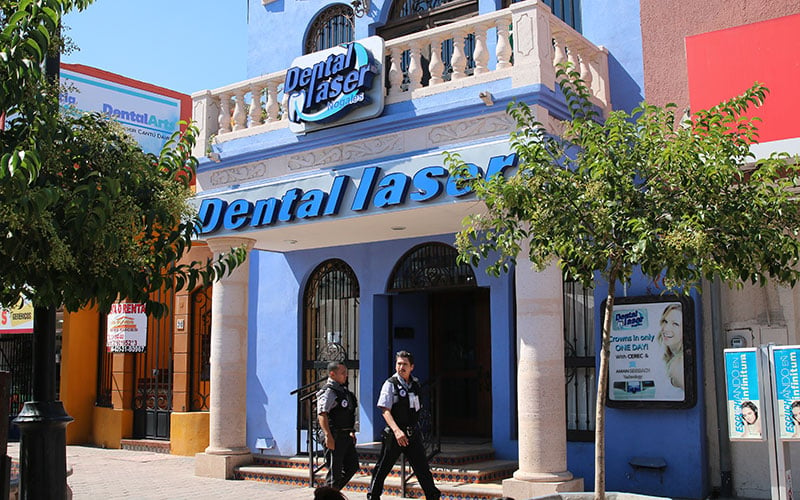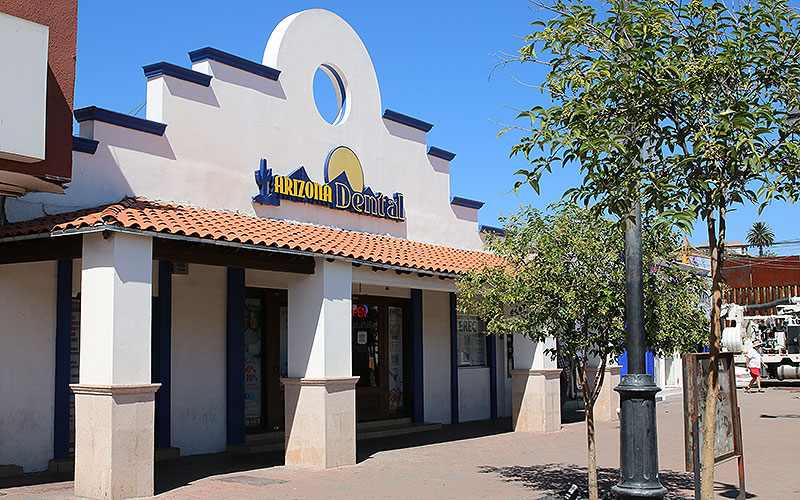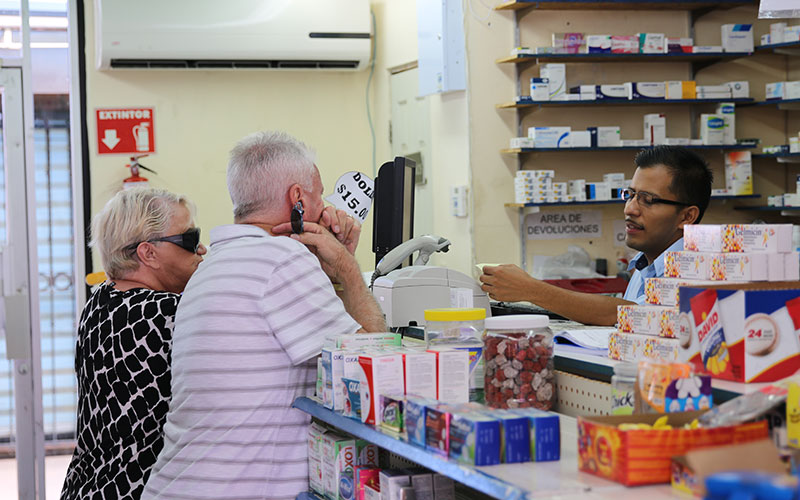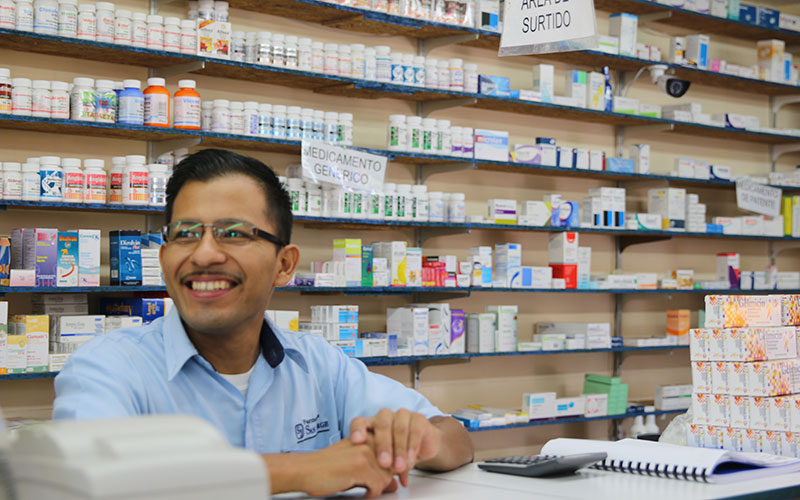
Dentists in Nogales attract patients from the U.S. looking for savings including $35 teeth cleanings that include x-rays. (Photo by Alicia Clark/Cronkite News)

Arizona Dental in Nogales, Sonora, one of dozens of dental clinics a couple block from the border crossing. (Photo by Alicia Clark/Cronkite News)

Crihstian Juarez Romero helps two Americans shopping at San Jorge Farmacias, a pharmacy in Nogales, Mexico. (Photo by Alicia Clark/Cronkite News)

Crihstian Fabian Juarez Romero at the San Jorge Pharmacy sees an increasing number of Americans crossing the border for low cost prescription drugs. (Photo by Alicia Clark/Cronkite News)
A slew of dental offices and pharmacies line a block of shops selling metal lawn sculptures shaped like donkeys, and handcrafted red and white Mexican dresses popular with American tourists.
Many visitors bypass the shops and head straight for the pharmacies and dentists strategically located just a few steps from the border crossing.
“Everything is at least 50 percent cheaper,” Jim Reed, 74, said. “It’s so expensive back home and it’s good quality we can afford here.”
Reed walked with his wife and son down the cobblestoned sidewalk after visiting a dental clinic.
“It was just $35 for a teeth cleaning,” said Keith Reed, 46, Jim’s son. “I don’t have insurance at home in Denver, so a cleaning there for me would be between $120 and $135, not including x-rays.”
Reed is a small business owner. His father has Medicare but that does not include dental coverage and he cannot afford supplemental insurance on fixed income.
“Everyone is kind of in the same boat. Things are getting too expensive back home so we are starting to come here for cheaper services.”
A new study from the Commonwealth Fund, a private foundation that aims to promote a high performing health care system, revealed that about 23 percent of Americans with coverage are considered underinsured—up from 12 percent in 2003 since the inception of Obamacare in 2012. That means roughly 31 million Americans who bought health insurance still have trouble affording treatment under their policies, according to the study.
“When Obamacare began, private insurance companies hiked up their premiums making it difficult for middle class Americans to get affordable health insurance,” said David Blunier, owner at Insurance Solutions, a brokerage company in Glendale.
The researchers at the Commonwealth Fund defined “underinsured” people as having out-of-pocket costs that total 10 percent or more of their annual income, or a deductible that is 5 percent or more of their income. The study concluded that high-deductible policies are likely the culprit behind this massive influx of underinsured people.
Since 2010, there has been some improvement in the share of low-income people who are underinsured, according to the Commonwealth Fund. Among adults who had health insurance for the full year, 42 percent of those with incomes under 200 percent of the federal poverty level ($22,980 for an individual and $47,100 for a family of four) were underinsured in 2014. Those people who fall in this category are often among those who cross the border for medical services.
A Gallup poll released in December 2014 found that about one in three Americans say they have put off treatment for themselves or a family member because of cost—the highest rate recorded in Gallup’s history.
According to Gallup about 38 percent of middle class people with a household income of between $30,000 and $75,000 per year have delayed medical care because of costs, up from 33 percent in 2013, and increasing each year.
While most uninsured people are in low-income families, middle class Americans are also struggling to pay their medical bills especially those who are aging.
Did you know thousands of Americans cross the border into Mexico for dental care and prescriptions? Look for the story @cronkitenews
— Alexa D’Angelo (@andangelo15) October 15, 2015
“It’s a common theme,” Reed said. “I see a lot of retired people who just can’t afford insurance period. Americans these days are lucky if they even have health insurance.”
Nearly 80 percent of travel for medical services is driven by cost savings, according to a 2013 survey by the Medical Tourism Association. Medical tourists spend between $7,475 and $15,833 per medical travel trip, with medical travel contributing between $45 and $95 billion to global GDP. Latin America is one of the leading regions for medical travel with Mexico having the highest demand for medical tourism.
Almost 76 percent of patients with a future interest in medical travel are American, according to the Medical Tourism Association.
Concerns about safety have kept many Americans from crossing the border into Mexico in recent years but now that some cities are calmer, tourists are returning to places like Nogales.
“When the violence decreased a few years ago, tourism increased and since then there has been a steady stream of people coming to across the border for medical services,” said Christopher Teal, U.S. Consul General in Nogales, Sonora.
“Dental services have become a huge industry here,” Teal said. “It’s high quality as long as people shop around and know what they’re getting for their money.”
Teal said that the number of folks crossing the border for dental work and prescription drugs steadily increases as snowbirds make their way to Arizona and other border states in the Southwest.
“Americans come here for price differences, speed and access that they can’t get back home,” Teal said.
Pharmacies in Mexico also see a spike in sales as temperatures dip in the U.S. “Many Americans come to us in the winter,” said Crihstian Juarez Romero, an employee at Pharmacia San Jorge in Nogales.
“Prices are much cheaper here,” Juarez said. The savings can range between 30-50 percent on some drugs. “As long as they have a prescription from America or Mexico, they can get whatever they need and cross back into the U.S. with it.”
“Often people come here to stock up on antibiotics, ” Juarez said.
He’s seen a lot more Americans shopping at the pharmacy in the last few years.
“Their insurance doesn’t cover the medicine so it’s very expensive,” Juarez said.”They prefer to come here and not spend as much.”
The Reed family plans to make more trips to pharmacies and dentists in Mexico in order to make ends meet.
“You can’t get any medical care on a fixed income back home,” Jim Reed said. “If I need to come here to get cheaper medicine and dental work, then that’s what I’m going to do.”